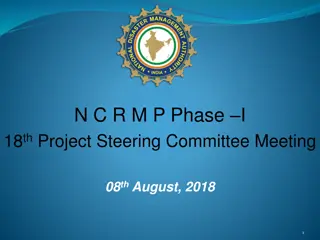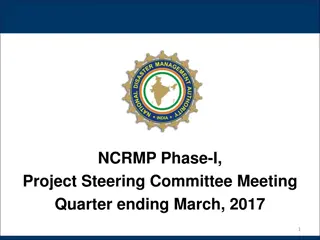
Breach of Contract Damages and Mitigation Strategies
Learn about breach of contract damages and mitigation strategies using the case of Rockingham County v. Luten Bridge. Explore concepts such as the expectation measure of damages, worthless construction projects, promise-kept positions, and the importance of timing in expenditures.
Download Presentation

Please find below an Image/Link to download the presentation.
The content on the website is provided AS IS for your information and personal use only. It may not be sold, licensed, or shared on other websites without obtaining consent from the author. If you encounter any issues during the download, it is possible that the publisher has removed the file from their server.
You are allowed to download the files provided on this website for personal or commercial use, subject to the condition that they are used lawfully. All files are the property of their respective owners.
The content on the website is provided AS IS for your information and personal use only. It may not be sold, licensed, or shared on other websites without obtaining consent from the author.
E N D
Presentation Transcript
Mitigation Richard Warner
Expectation Measure So Far The fundamental goal: The fundamental goal of awarding damages for breach of contract is to put the injured party in as good a position as he or she would have been in if the promise had been kept. The three steps of the expectation measure of damages. First: Where would the injured party be if the promise had been kept? Second: what losses did the injured party suffer as a result of the breach? Third: award enough money to move the injured party from the breach-position to the contract-performed position
Rockingham County v. Luten Bridge Rockingham County hired Luten Bridge to build a bridge across a river. Before Luten Bridge completed construction, the County announced that they no longer wanted the bridge and would not pay for it. That announcement is a breach of the contract. Technically, it is an anticipatory repudiation (=the definite and unequivocal announcement of the intention to breach). It is itself a breach. After the announcement, Luten Bridge completed the construction of the bridge.
A Useless Bridge The completed bridge has no value. No road connects to it on either side. The bridge is useless.
Promise Kept Position Where would Luten Bridge be if the promise had been kept? Assume they would have been paid $23,000 (about $350,000 in 2021 dollars), and they would have spent $18,000 building the bridge. So in the promise-kept position, they would have: $5000 net profit.
Losses As A Result of the Breach What losses did the Luten Bridge suffer as a result of the breach? They spent $18,000 building the bridge They receive no payments from the county. As a result of the breach, they are: Minus $18,000.
The Award If We Follow Hawkins We award enough money to move Luten Bridge from the breach-position to the contract-performed position. We would award them $23,000 because they are minus $18,000 and should be plus $5000.
The Timing of the Expenditures We can divide Luten Bridge s expenditures into before and after the County s announcement. Assume these are the numbers. Before: $6,900 After: $11,100. Should Luten Bridge have spent the $11,100 after the announcement? (a) Yes, (b) No
The Courts Position The court only awards losses caused by the breach up to the time of the announcement that the city will not pay. It awards nothing for losses after that.
The Duty to Mitigate The injured party after the breach should take all reasonable steps to reduce the losses from the breach. This is not really a duty the injured party commits no legal wrong if it does not mitigate. You just cannot recover costs avoidable by mitigation. What courts do is give you an award that will put you in the "as good as" position provided that you have mitigated properly.
What Is Mitigation? Mitigation (avoidability) consists in reducing losses from the breach of contract. True or false: All of these losses are from the breach in Hawkins v. McGee A hairy ugly hand Embarrassment Loss of earnings Pain and suffering not normally part of the operation (a) True (b) False
A Second Operation If George had a second successful operation to restore his hand to a non-hairy condition, that would reduce the losses from the breach. (a) Yes (b) No
Mitigation Overview Proper mitigation means taking all reasonable steps to reduce damages after a breach. The non-breacher can only recover losses not avoidable by proper mitigation. An action that that has some likelihood of reducing damages can be proper mitigation. The non-breacher recovers expenses involved in mitigation. For an action to be proper mitigation it must be appropriately related to the activities required under the contract.
Different Ways To Value Charles Whitbread III inherited an all wooden sailing schooner from his father. The boat- -The Aphrodite--is famous, among the sailing community, as one of the last and most beautiful examples of its kind. It has considerable aesthetic and historical value as well as considerable sentimental value to Charles. It has a market value of approximately $1,000,000. The schooner needs repair and restoration. Charles hires Mike Gougen to do the repairs. The contract calls for an all wood restoration and prohibits the use of fiberglass impregnated wood. The price is $100,000. Gougen repairs the boat, but he uses fiberglass impregnated wood. The repaired boat has a market value of $1,150,000. When Whitbread discovers that some of the wood is fiberglass impregnated, he hires Sarah Woode, who replaces all the fiberglass impregnated wood with regular wood. She charges $200,000 for doing so (assume this is a reasonable price for the work). The fully wooden restored boat has a market value of $1,150,000. (a) It was proper mitigation to hire Woode. (b) It was not proper mitigation to hire Woode. (c) Whether it was proper mitigation to hire Woode depends on how you measure value.
Another Acting Job After the movie company breaches its promise to give Tony the part of Mad Dog in the movie, Tony immediately finds another acting job as the older brother in a TV remake of Leave It To Beaver. You would reduce the damages the movie company owes Tony by the amount he makes from his new acting job (for the period of time during which Tony would have been employed by the movie company). (a) Yes (b) No
Selling The Record Collection After the movie company breaches its promise to give Tony the part of Mad Dog in the movie, Tony decides to raise som extra money by selling his vinyl record collection You would reduce the damages the movie company owes Tony by the amount he made from selling the collection. (a) Yes (b) No
Mitigation in the Employment Context Parker v. 20th Century Fox (1970): Shirley MacLaine had a contract to appear in the musical "Bloomer Girl a movie about the woman s right to vote movement. Fox breached the contract by not making the movie. It offered her the leading female role as the love interest of the leading male role in a western, "Big Country, set in Australia.
Why The Job Offer? Why did the movie company offer her another role? One likely reason was to provide her with an opportunity to mitigate her damages from the breach. (a) True (b) False
What Happens If She Takes The Job Assume taking the job mitigates damages in the movie versus waiter sense. Then the court reduces the award of damages by the amount of damages avoided by taking the job. It does not matter if taking the job would not have been proper mitigation = a reasonable mitigation step.
Proper Mitigation in Parker The court did not think MacLaine s accepting the role of the romantic lead in Big Country would have been proper mitigation. Why? Because it was "different and inferior. That is the rule in employment cases: taking a job that is different and inferior is not proper mitigation and so if not taken its earning are not deducted from the award.
Puzzles Every job is different from every other job in some way. (a) True (b) False
The Point The Dissent Makes The dissent makes this point: every job is different in some way. The dissent notes that the law is not: in employment cases: taking a job that is just different is not proper mitigation It has to be inferior. So the majority must hold that the role in Big Country was inferior.
Another Problem Parker is an appeal from a summary judgment motion (MacLaine won in the trial court). A court will only grant summary judgment if Given the facts the parties agree on or which no reasonable mind could disagree about There are no triable issues of material fact. The parties do not agree the Big Country is inferior, and reasonable minds could differ And it seems whether Big Country is inferior is a triable issue of material fact.
But The Majority Says . . . The offer of the "Big Country" lead was of employment both different and inferior, and . . . no factual dispute was presented on that issue. What is the explanation for the majority s view?
The Explanation The majority thinks the two jobs are significantly different kinds of jobs. The mere circumstance that "Bloomer Girl" was to be a musical review calling upon plaintiff's talents as a dancer as well as an actress, and was to be produced in the City of Los Angeles, whereas "Big Country" was a straight dramatic role in a "Western Type" story taking place in an opal mine in Australia, demonstrates the difference in kind between the two employments; the female lead as a dramatic actress in a western style motion picture can by no stretch of imagination be considered the equivalent of or substantially similar to the lead in a song-and-dance production.
But Still A Triable Issue? Is whether the jobs are different in kind a triable issue of material fact? (a) Yes (b) No
More Explanation We give the non-breacher the benefit of the doubt about whether the job was inferior. Because so many subjective factors matter in that decision. MacLaine s rejection of Big Country makes it presumptively inferior, and the movie company did not present evidence sufficient to overcome that presumption.
Dividing The Damages Mitigation divides the damages between the breacher and the non-breacher. The breacher pays for damages not avoidable by proper mitigation. The non-breacher bears damages that the non-breacher did not avoid but should have avoided through proper mitigation. Is this consistent with the fundamental goal? The goal is to put the injured party in as good a position as he or she would have been in if the promise had been kept. (a) Yes (b) No
The Expectation Measure So Far The three steps: First: Where would the injured party be if the promise had been kept? Second: what losses did the injured party suffer as a result of the breach assuming proper mitigation. Third: award enough money to move the injured party from the breach-position to the contract-performed position This divides the damages between the breacher and the non- breacher.




















